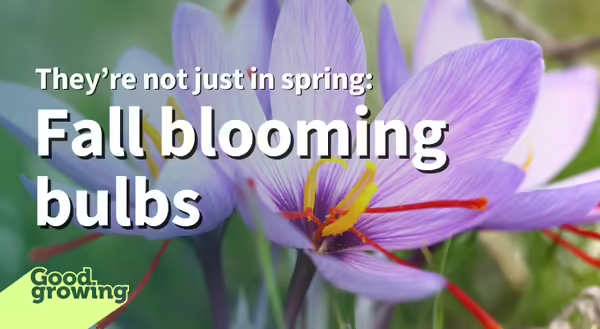
When it comes to bulbs, this time of year (fall), much of our attention is focused on getting ready to plant spring-blooming bulbs, and rightfully so. From crocus and daffodils to tulips and alliums, these plants provide a burst of color early in the year before many of our landscape plants begin blooming. While spring-blooming bulbs get most of the attention, there are some bulbs that will bloom in the fall that can also provide a splash of color to a landscape.
Autumn crocus (Colchicum spp.)
Despite their common name, these plants aren’t true crocus. In fact, they aren’t even in the same family. Colchicum belongs to the Colchicaceae family (formerly part of the lily family, Liliaceae), while Crocus is in the iris family (Iridaceae). There are approximately 65 species of Colchicum, with C. autumnale being the most commonly grown, along with a variety of hybrids.
Colchicums will begin producing leaves in the spring. Each bulb (actually a corm) will have three to eight leaves that are 8-14-inches tall. The leaves are often compared to those of tulips and hosta. As the weather begins to warm in late spring and early summer, the leaves will begin to die back. Then, in early fall, the plants will begin to produce flowers. Each plant typically produces between three and eight flower stalks, and each stalk will have one flower. The 2-3-inch blooms can last for up to two weeks and are usually light pink, but some cultivars are white.
Colchicums are hardy to zone 5 and grow best in well-drained soils in full sun or partial shade. Ideally, they should be in full sun conditions while they have leaves. Since their leaves can be unattractive, some people interplant them with plants that bloom in the spring and early summer to hide the foliage.
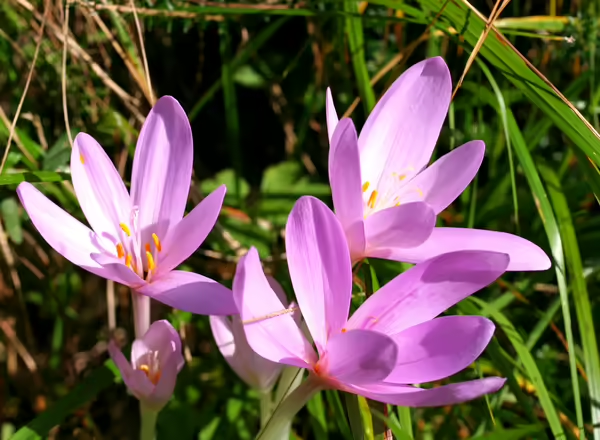
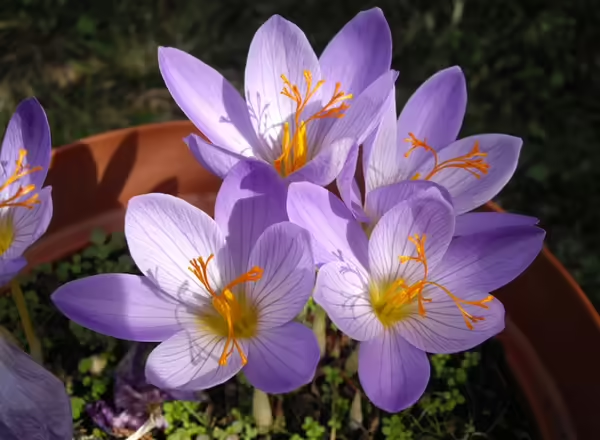
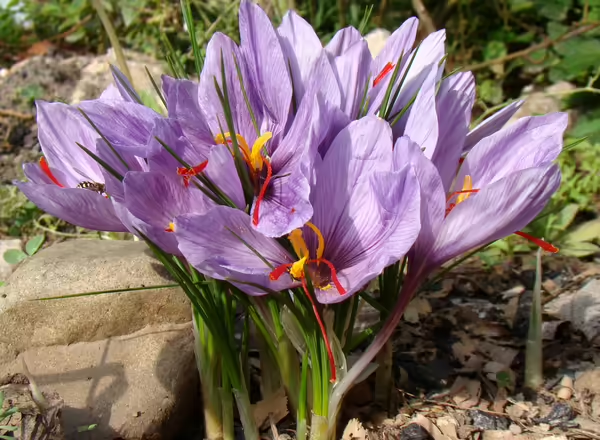
Crocus (Crocus spp.)
While spring-blooming crocuses get a majority of the attention, several species of crocus will bloom in the fall. These plants will often produce flowers before or as leaves emerge, and the leaves will persist after the plants are done blooming.
The most commonly grown species is probably Crocus speciosus, which is also called Autumn crocus, but you may also see it referred to as showy crocus. They are one of the earliest fall-blooming crocuses and emerge in early fall. The plants will send up 6-7-inch-tall flower stalks with typical goblet-shaped crocus flowers that are violet-blue to mauve.
Saffron crocus (Crocus sativus), while not the most widely grown fall-blooming crocus, is probably the most known. This is the plant that the spice saffron comes from. The plants grow 4-6 inches tall and have lilac-purple flowers that open a few weeks after C. speciosus. Each flower produces three reddish-orange stigmas and styles, which are harvested and dried to create saffron. It takes about 250,000 stigmas and styles from 75,000 flowers to produce 1 pound of saffron, all of which is handpicked. Now you know why saffron is so expensive.
There are several other species of fall-blooming crocus, including C. goulimyi, C. kotschyanus, C. medius, C. pulchellus, and C. ochroleucus.
Most fall-blooming crocuses are hardy to zone 3. One exception is the saffron crocus, which is hardy to zone 6. Crocuses do best in sunny, well-drained locations. Despite being referred to as bulbs, these plants also grow from corms.
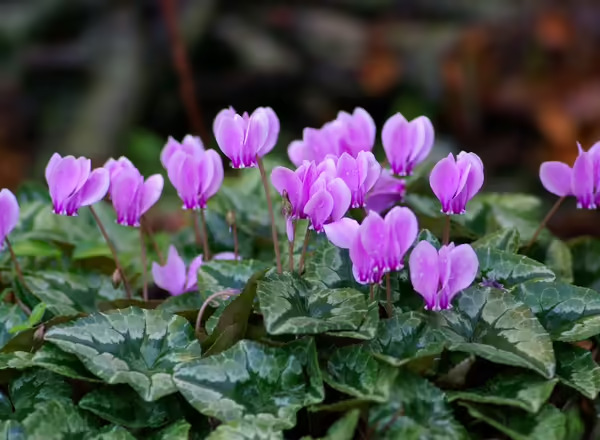
Hardy cyclamen (Cyclamen hederifolium)
When it comes to cyclamens, we’re probably most familiar with those sold as houseplants during the winter (Cyclamen persicum). Alas, these cyclamen are tender plants and aren’t hardy here in Illinois. However, there are some hardy cyclamen, one of them being C. hederifolium.
Hardy cyclamen grows to 4-6 inches tall. The plants will produce pink to white flowers that are 1-2 inches long with swept-back petals from September to October. While the flowers are the main attraction, the foliage is also attractive. The leaves are heart-shaped (similar to ivy) with dark green centers bordered with lighter green and silver patterns. Plants will produce foliage after their flowers, and the foliage will persist through the winter before going dormant in spring.
Hardy cyclamen can be grown in zones 5-9. They grow best in moist, well-drained soils that are high in organic matter. They prefer partial shade, particularly during the afternoon. Hardy cyclamens can be long-lived and will spread but can take some time to get large. While young plants may only produce a few flowers, older established plants can be very prolific bloomers.

Autumn daffodil (Sternbergia lutea)
If pink and purple aren’t for you, then check out autumn daffodil (Sternbergia lutea). These plants produce bright yellow crocus-like flowers from September to October. Flowers can reach 1.5 inches in width, and flower stalks are typically around 6 inches tall. The foliage of these plants is narrow and lance-shaped and can reach 12 inches in length. The foliage can persist through the winter, especially in warmer locations, eventually dying back until the fall. The long-lasting foliage can provide some nice green color in an otherwise dreary winter landscape.
Bulbs should be planted 5 to 6 inches deep in well-drained soil in full to part shade. Because they like well-drained soils, they are often grown in rock gardens or raised beds (particularly in areas with heavy clay soils). While they are commonly listed as hardy to zone 6, you may need some extra precautions to get them to overwinter, such as placing them near a building with southern exposure or a protected location and mulching.
When should I plant fall-blooming bulbs?
While we typically think of fall as the time to plant bulbs, the best time to plant many fall-blooming bulbs, like Colchicum, Crocus, and Sternbergia, is in mid to late summer while the plants are dormant. Hardy cyclamen are often planted in spring.
Next time you’re looking to purchase some bulbs, consider adding some that bloom in the fall. They can be a great colorful addition to your fall landscape and pair nicely with other fall-blooming plants such as asters, goldenrods, and mums.
Good Growing Tip of the Week: While fall-blooming bulbs aren’t commonly found at garden centers and box stores, various companies sell them online.
Resources and for more information
Armitage, A M. 2020. Herbaceous Perennial Plants : A Treatise on Their Identification, Culture, and Garden Attributes. Champaign, Illinois: Stipes Publishing, LLC.
Photos
Autumn Crocus (Colchicum autumnale) photo by Enrico Blasutto, CC BY-SA 3.0.
Showy Crocus (Crocus specious) photo by Ghislain118, CC BY-SA 3.0.
Saffron Crocus (Crocus sativus) photo by Yuri Danilevsky, CC BY-SA 4.0.
Hardy cyclamen (Cyclamen hederifolium) photo by Hamon Jean-Pierre, CC BY-SA 3.0.
Autumn daffodil (Sternbergia lutea) photo by A. Barra, CC BY-SA 4.0.
Want to get notified when new Good Growing posts are available? SIGN UP HERE!
Give us feedback! How helpful was this information (click one): Very helpful | Somewhat helpful | Not very helpful
MEET THE AUTHOR
Ken Johnson is a Horticulture Educator with University of Illinois Extension, serving Calhoun, Cass, Greene, Morgan, and Scott counties since 2013. Ken provides horticulture programming with an emphasis on fruit and vegetable production, pest management, and beneficial insects. Through his programming, he aims to increase backyard food production and foster a greater appreciation of insects